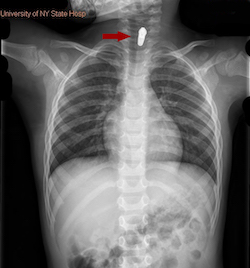Swallowed Toy Magnets Are the Cause of an Alarming Rise in Such Injuries in Kids
Children's toys are potentially dangerous, and it's that time of the year to be especially mindful of this fact. Foreign body ingestion by children represents a major challenge to the treating physicians and to the parents/guardians.
Diagnosis can often be challenging because not all ingested objects can be seen by routine x-ray exams.
Only metallic objects can be seen by x-ray. Objects made out of plastic and glass can be easily missed. Diagnosis, therefore, is often made by direct observation with a history of choking, or new onset of certain symptoms.

Of the many ingestion injuries treated by our Pediatric Surgery Service, one involved a little boy who had sudden chest pain and was brought to our ER: he had swallowed a toy part that lodged in his esophagus (see x-ray).
Treatment of a swallowed or inhaled foreign body is dependent on the location and the type of the foreign body. In the digestive tract, if the object is stuck in the esophagus and fails to pass into the stomach, it must be removed using endoscopic techniques.
A foreign body that passes into the stomach may be observed without intervention, because it may pass through the intestine and exit with stool. Even sharp objects such as pins can pass without perforating the intestine. The passage into stool can take up to one to two weeks.
Certain types of ingested objects represent a major concern: button batteries and super magnets (neodymium magnets; typically 10 to 20 times stronger than traditional magnets) are two of the most common types.
Therefore, our Pediatric Surgery Service tries to remove all of such batteries when seen in the esophagus. Once a battery passes into the intestine, it can only be watched, with the hope it will pass out with the stool without damaging result.
Button batteries can be easily swallowed, and these batteries release corrosive chemicals that can erode through the esophagus and intestine if they fail to move.
Magnets are another type of object that has been identified as especially dangerous. In recent years, many reports of ingested small magnets eroding through the bowel by magnetic force have appeared in the medical literature.
The authors of a study published last year, titled "Button Battery and Magnet Ingestions in the Pediatric Patient," observed that button battery and magnet ingestions have increased in incidence over the past two decades. They concluded the sooner ingestion of these objects is suspected, and the sooner they are removed from a child, the better the outcome.
Stony Brook Children's is the only hospital in Suffolk County with board-certified pediatric surgeons who treat children with toys ingested into the airway and digestive tract.
Magnets that are swallowed can clump together on opposite sides of the intestinal wall, and their pinching action can be so tight that holes are made in the intestine, thus creating a dangerous problem.
The current standard of care for children who have more than one magnet is to consider performing emergency abdominal surgery.
A foreign body inhaled into the airway by children is a surgical emergency. Many objects have been identified as high risk for inhalation by young children. These include popcorn seeds, peanuts, latex balloons, etc. Unusual inhaled objects seen at Stony Brook Children's include a broken Monopoly game piece and a screw.
Observing choking with an object in the mouth may be the only history. Sometimes, it is a child with new onset wheezing. Chest x-ray may not necessarily make the diagnosis. Rigid bronchoscopy is the used for both diagnosis and treatment.
During the holiday season, children's gifts need to be age appropriate for many reasons. Prevention of foreign body ingestion is one of them. However, this is a problem seen throughout the entire year at Stony Brook Children's Hospital.
Stony Brook Children's is the only hospital in Suffolk County with a team of fellowship-trained pediatric surgeons who treat children with toys ingested into the airway and digestive tract. We also have specialists from our pediatric emergency department who can make the diagnosis, and pediatric otolaryngologists who can perform all of the above procedures in children.
Foreign body ingestion injuries related to toys often happen when parents overestimate their child's level of development and make the mistake of buying a toy beyond the suggested age range: toys designed for older children may contain parts that are choking hazards.
The authors of another study, titled "Toys in the Upper Aerodigestive Tract," concluded that in addition to requiring product modifications by toy makers, improving parents' awareness of foreign body ingestion injuries and increasing their watchfulness of their children must occur to help prevent these injuries.
Harmful If Swallowed
Here's a very partial list of toy types/parts that young children have swallowed and that have sent them to the emergency room:
- Ball bearings
- Board game pieces
- Button batteries
- Doll shoes
- Lego-type toys (interlocking bricks)
- Magnetic beads & construction toys
- Marbles
- Plastic coins
- Plastic toys (esp. pieces of them)
- Puzzle pieces
- Round small toys
- Toy insects
- Toy soldiers
- Toy train signs
- Wheels of toy cars & other vehicles
ALERT: Children under the age of 3 should not play with toys that could fit inside a toilet paper roll. Check the U.S. Consumer Product Safety Commission website to make sure your children's toys are not recalled products.
Listen to our chief of pediatric surgery Christopher S. Muratore, MD, who in a WSHU radio interview offers advice on how to recognize an ingestion injury in a child and what to do.

